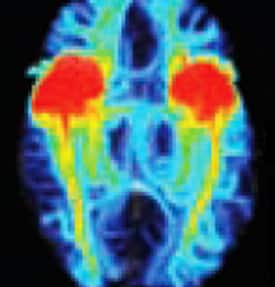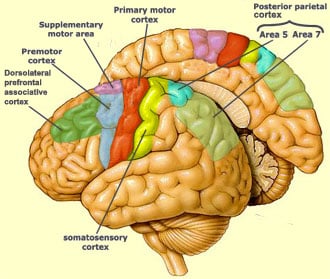- Scores on neuropsychological tests show amount of damage done to person

- Destruction and Stimulation test: can destroy parts of the brain to see effect or stimulate nerves with electrodes (Dr. Penfield- famous neuroscientists) – mapped motor and sensory areas
- Broca’s aphasia: could understand, but not speak
- Dorsal Stream: action (D.A)
- Ventral Stream: perception (V.P)
- Single- Neuron Recording: recording single neurons and its frequency of firing
- Electrical recording: use (EEG) Elctroencephalogram to measure electrical activity of electrons ; (from outside 1000s) which correspond with certain states of being awake or asleep.
- Event-related Potentials (ERPs) changes in EEG due to a psychological event
- Braining Imaging: use (CT) computerized axiel tomography scans the brain with Xrays to take pictures of brain.
- (PET) positron emission scans measure brain activity, metabolism and blood flow. Patient is injected with radioactive glucose which the neurons consume; the brain will show different intensities of the dye for how many neurons consume it.
- (MRI) magnetic resonance imaging. Combines CT and PET to study both brain structure and activity. Uses a magnetic pulse; more sensitive than CT or PET.
- fMRI- Functional MRI; blood flow increases as function of neural activity
- MRI= brain anatomy fMRI= studies brain function
- Prosopagnoisa: can’t recognize faces; friends or themselves; but can recognize objects
- Diffusion Tensor Imaging (DTI): views the way different parts of the brain are wired together
- Magneto- encephalography (MEG): allows scientists to directly see neurons fires
GOAL OF BEHAVIOURAL NEUROSCIENCE HAS BEEN TO RECORD ELECTRICAL, CHEMICAL AND MAGNETIC CHANGES IN BRAIN ACTIVITY AND TO CORRELATE THEM WITH SPECIFIC MENTAL AND BEHAVIOURAL PHENOMENA.
Anatomical Directions: (dorsal, top) / (ventral, down) / (Posterior, back)/ (Anterior, front)/ Lateral (side)/ Medial (cut in middle)
Hindbrain
Made of :
- brain stem and medulla oblongata (regulates autonomic functions- heart beat, breathing etc.)
- pons (bridge) connection between higher and lower brain; regulates sleep/ dreams/ muscle movement
- Cerebellum (little brain) mainly grey matter, used for muscular movement and coordination; told by thalamus to do something, sends impulses to afferent nerves. (involuntary movements)

Midbrain
- Contains sensory and motor neurons; connected from higher and lower brain.
- Contains Reticulum (net- finger shaped) acts as sentry, allowing messages to reach higher brain or block them. Ascending warns brain it coming Descending admits or blocks sensory input.
- Need to warn higher regions of incoming stimulation or else it might not register. (controls sleep, wakefulness and attention)
- Attention: process in which only meaningful impulses are registered; others are ignored.
Forebrain (Cerebrum)
- Two frontal cerebral lobes connected by corpus callosum , covered by cortex which is our consciousness
- Thalamus: located above midbrain, “switchboard” router of sensory information registering in upper brain and then sending impulses to correct organs. “creates perception”
- Basal ganglia: surrounding the thalamus in 5 structures; important for initiating voluntary movement.
- Hypothalamus: controls different biological drives; sexual, temperature, eating, drinking, aggression.
- Limbic system: found deep in hemispheres; coordinates behavior needed to satisfy motivational/ emotional needs caused by hypothalamus.
- Made of: Hippocampus: forming/ retrieving memories (spatial orientation) amygdale: controls aggression/ fear (can work without higher brain)
- Nucleus accumbens: important for motivation and reward (pleasure centre)
- Capgras delusion: is a disorder in which a person holds a delusion that a friend, spouse, parent, or other close family member has been replaced by an identical-looking impostor. This is because they have no arousal in emotion to the individual.
- Cerebal Cortex: wrinkled and convoluted; our conscious! Deep folds- fissures;
- Frontal Lobe– associated with reasoning, planning, parts of speech, movement (motor cortex), emotions, and problem solving (makes us human)
- Parietal Lobe– associated with movement, orientation, recognition, perception of stimuli (somatic cortex) input from multiple areas; out to frontal lobe
BOTH SENDING IMPULSES TO OTHER HEMISPHERE; ARRANGED UPSIDE DOWN!
- MOTOR: LIPS, TONUGE, FINGERS,

- SOMATIC: FINGERS, LIPS, TONGUE
- Occipital Lobe– associated with visual processing
- Temporal Lobe– associated with perception (visual input will go there) and recognition of auditory stimuli, memory, and speech
- Broca’s area: formulate speech responses (in frontal lobe)
- Motor Cortex: stimulates muscles that produce speech; muscle movement (in frontal lobe)
- Wernicke’s Area: processes incoming speech and comprehends it
- Wernicke’s understands it, Broca’s formulates the responses, Motor cortex stimulates muscles to produce speech
- Association Cortex. Found in all lobes, involved in HIGHER THINKING, Silent areas. Involved in perception/ thought, no sensory/motor response when stimulated.
- Frontal lobe accounts for human difference in intelligence, self-awareness, planning etc.
- Prefrontal cortex: executive functions: goal setting, judgment, strategic planning, impulses control etc.
- Those who lack, lack executive function, can’t see future consequences; killers.
- Corpus callosum: neural bridge that acts as communication link between two hemispheres
- Landmarks: gyrus= hills suclus= valleys fissure= large suclus
- Lateralization: refers to greater localization for a function in one hemisphere or the other

Thanks for such wonderful information , i studied Psychology and I really need to be updated and this is one of the best source i found where i got all the links and the knoledge in details and the best of all i will used to make a Lecture for Parents and students , at Loma Linda for AUTISM, Where I worked as a therapist and Behavior Modification Instructor.
I am really grateful for ur page.
Thanks MRS. PENA.